Overview
Supply chain disruption and persistent inflation remain critical issues in the global economy, with ongoing geopolitical tensions, the evolution of digital threats, and increasing emphasis on sustainability reshaping the landscape. These disruptions highlight vulnerabilities in traditional supply chain models, prompting a reevaluation of strategies to enhance resiliency and adaptability. We will explore the latest trends impacting international and domestic supply chains in 2024, as well as their causes, impacts, and strategies for mitigating disruptions, offering a comprehensive framework for manufacturers to navigate this complex environment.
The manufacturing sector is particularly vulnerable to supply chain disruptions. As a cornerstone of economic stability and growth, manufacturing relies heavily on seamless supply chain operations. Any disruption can lead to delays, increased costs, and inefficiencies that ripple throughout the economy. Recent years have highlighted the fragility of supply chains, causing significant economic and operational challenges. We will provide insights into the nature of supply chain disruptions and propose actionable strategies for building more resilient supply chains in 2024.
Current State and Latest Trends Impacting Supply Chains
The pressures and long dwell times that had impacted global supply chains during the pandemic years have eased, and supply and demand have largely come back into balance.
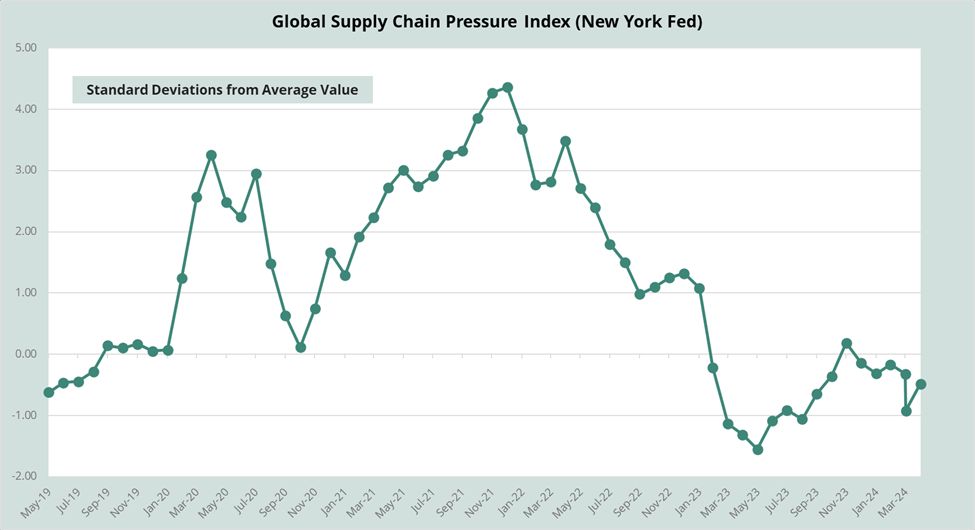
Source: Federal Reserve Bank of New York, Global Supply Chain Pressure Index
However, American supply chains face significant challenges, including a largely uncommitted workforce, aging infrastructure, and unreliable trading partners, compounded by global tensions. China's economic slowdown is impacting businesses worldwide, while ever-changing tariffs, regulations, and political realities continue to create instability. Consequently, manufacturers must stay vigilant by regularly evaluating their current situation while ensuring effective contingency plans are in place.
- Persistent inflation continues to impact the raw material costs of manufactured goods. The cost of industrial chemicals, iron and steel scrap, and some agricultural products (grains, turkeys, oilseeds, fresh fruits, and vegetables) have decreased vs. 2023. However, many commodities are still experiencing significant cost increases such as eggs, liquified petroleum gas, pork, dairy products, chickens, coffee, and many types of industrial machinery.
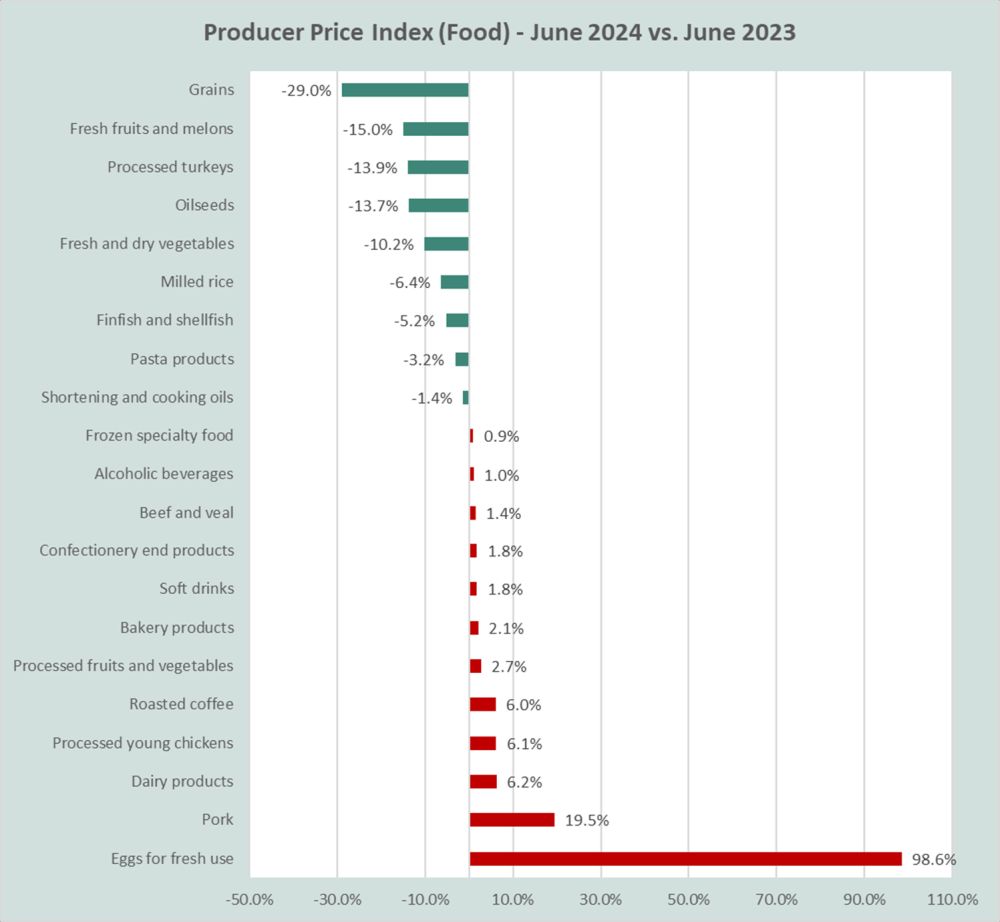
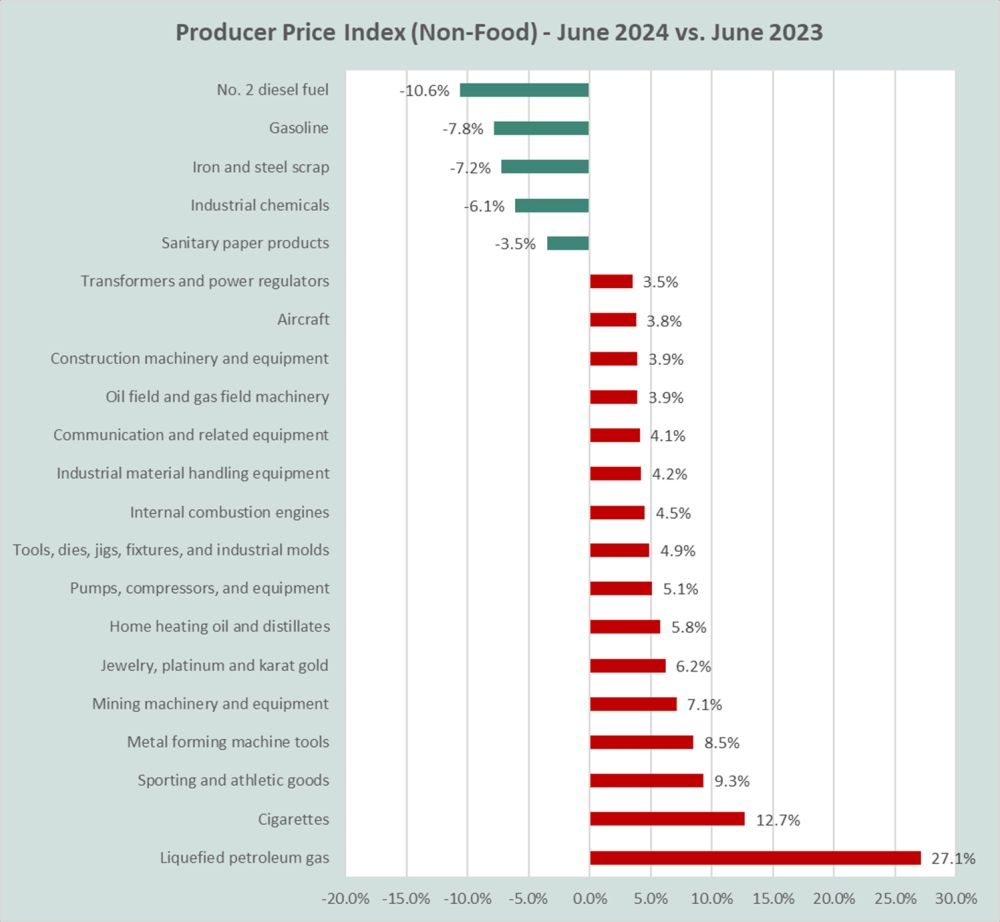
Source: Bureau of Labor Statistics, June 2024
- Even minor impacts on supply chain and/or material costs can destroy EBITDA and have a devastating impact on liquidity, covenants, and potentially survival.
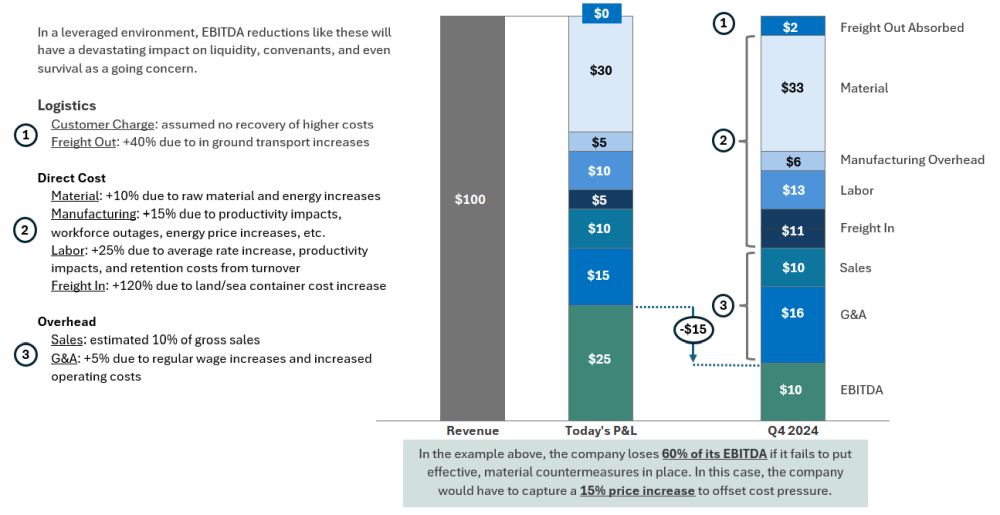
For illustrative purposes only
- Geopolitical tensions continue to shape global supply chains and destabilize manufacturing. The ongoing U.S.-China trade conflict, the war in the Middle East, continued hostilities between Russia and Ukraine, and shifts in trade policies have led to increased tariffs, trade barriers, and uncertainties. These fluctuations require manufacturers to adapt swiftly, often leading to increased operational costs and strategic shifts.
For instance, abrupt tariff changes can quickly alter the cost structure of manufacturing inputs, affecting pricing strategies and profit margins with little time to react. However, according to a report by the World Trade Organization (WTO), global merchandise trade is expected to grow 2.6% in 2024, up from -1.2% in 2023, despite ongoing geopolitical factors.
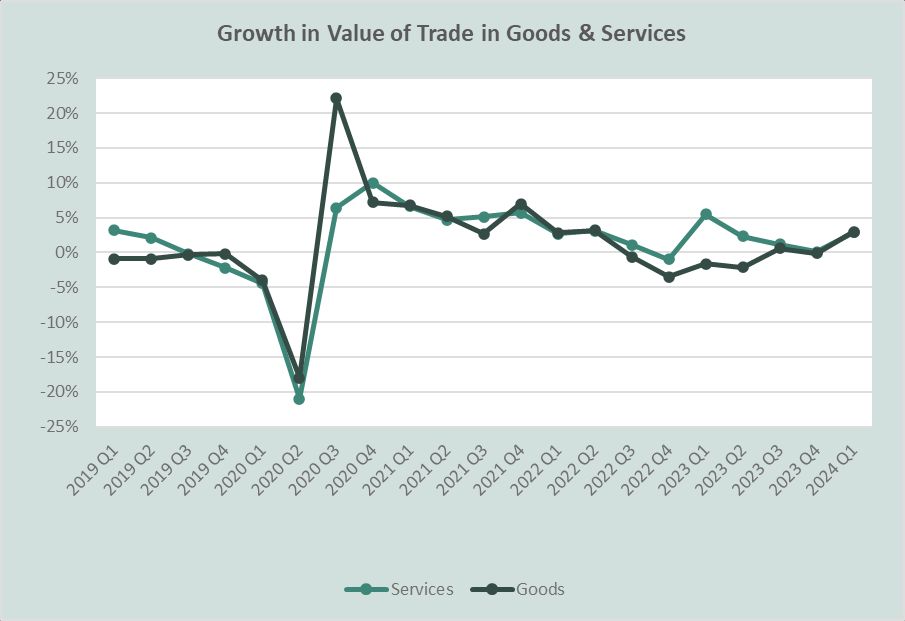
Source: United Nations Center for Trade and Development
However, the war in Ukraine and Israeli action against Iranian proxies Hamas, the Houthis, and Hezbollah is creating significant uncertainty. Houthi attacks on commercial shipping in the Red Sea are significantly driving up the cost of shipping, especially to the East and West coasts of the United States. This increasing cost may end up driving higher levels of inflation as we move through 2024, due to the increased expense that will impact the seasonally high-volume holiday shipments.
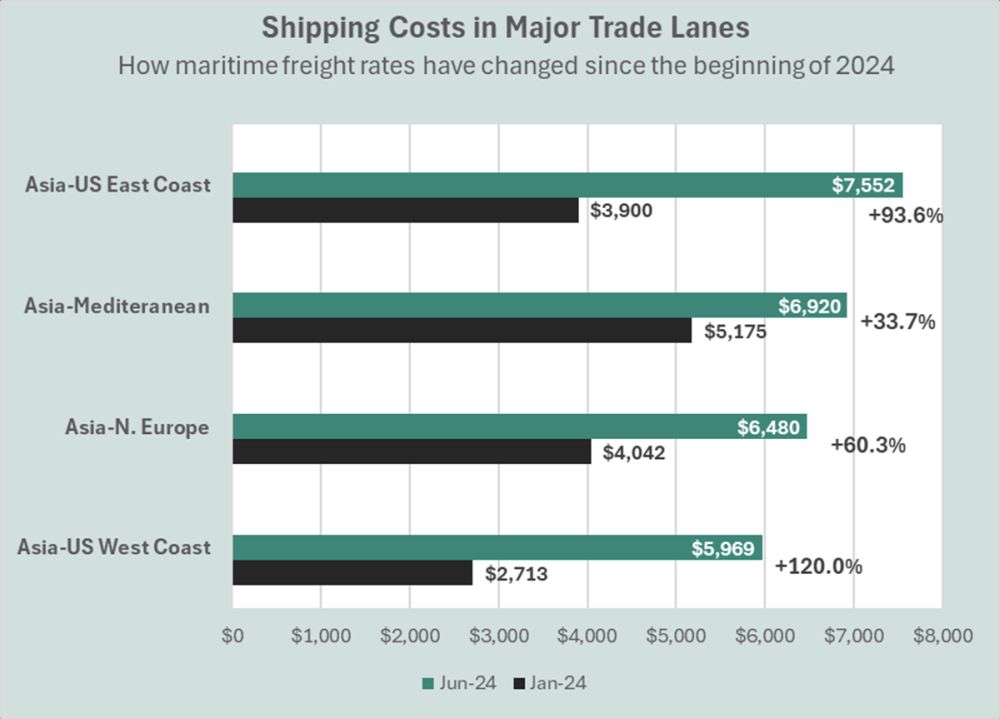
Source: Freightos - as of June 20th, 2024
- The rapid advancement of technology has a dual impact on supply chains. While innovations such as artificial intelligence (AI), the Internet of Things (IoT), and blockchain enhance efficiency and transparency, they also increase the risk of cyberattacks and ransomware. Recent estimates suggest that global cybercrime costs will reach $10.3 trillion annually by 2025, highlighting the growing threat to digital supply chains.
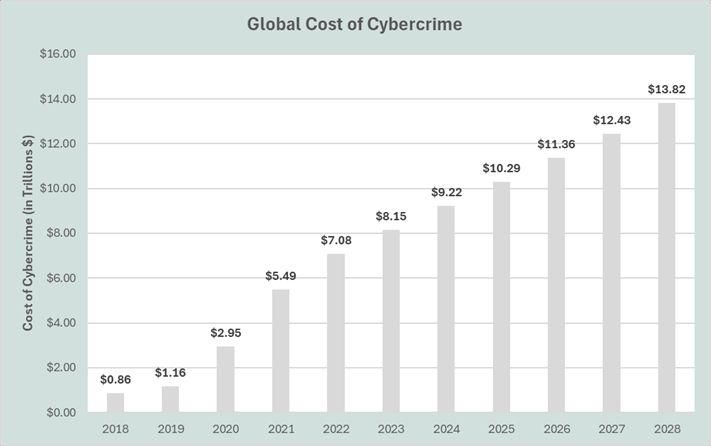
Source: Statista Market Insights September 2023
A recent example includes the CDK dealer management system cyber-attack-led software outage that impacted 15,000 auto dealerships across the United States. The outage impacted the system used to complete deals, track store profitability and monitor employee compensation. This has thrown the retail auto industry into disarray.
Another significant example is the global mass IT outage related to the CrowdStrike software update on July 19th. This outage impacted a wide range of industries including, but not limited to airlines, banking, retailers, and hospitals, as well as parcel services.
- Labor shortages and disruptions, exacerbated by demographic shifts such as an aging workforce, and changing workforce expectations (rising wage rates), continue to challenge manufacturing supply chains. The U.S. Bureau of Labor Statistics projects a 4.5% decline in the labor force participation rate by 2030. In response, companies are investing in automation and robotics to maintain productivity and efficiency. This is in addition to the threat of a pending Longshoremen's strike which could impact the East and Gulf Coast ports as early as October 2024.
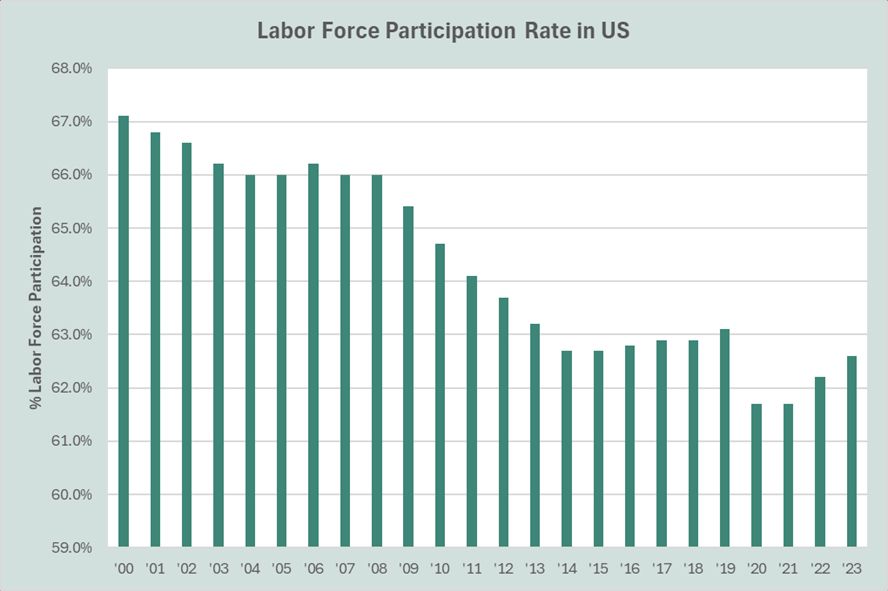
Source: St. Louis Federal Reserve
- Climate change-induced natural disasters are becoming more frequent and severe, disrupting supply chains globally. The Intergovernmental Panel on Climate Change (IPCC) reports that the economic impact of climate-related disasters is expected to increase, with global losses projected to reach $2 trillion annually by 2030. Examples of supply chain implications from Climate change and related disruptions are evidenced by low water levels in Panama's Lake Gatun, which is restricting the flow of container ships through the Panama Canal, as well as the impact of floods, hurricanes, and wildfires
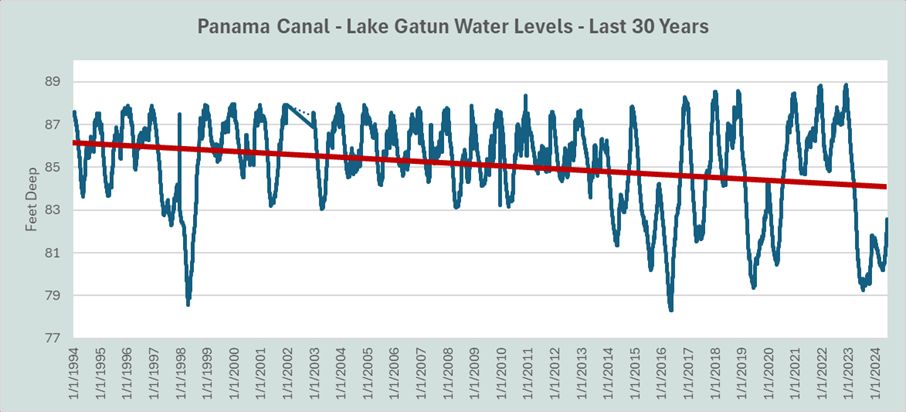
Source: Panama Canal Authority
- Unforeseen man-made disasters such as the Key Bridge collapse in the Port of Baltimore, or the East Palestine train derailment can instantly break supply chains and cause significant disruption.
- Sustainability is increasingly becoming a key driver in supply chain management. Companies are under pressure to reduce their carbon footprints and ensure ethical sourcing. This is causing the need for increased capital investment to achieve higher degrees of ESG compliance.
Impacts of Supply Chain Disruption
Disruptions can lead to significant financial losses due to production delays, increased costs, and lost sales. The Business Continuity Institute's 2023 report indicated that 68% of companies faced increased operational costs due to supply chain disruptions.
- Supply chain disruptions can cause operational bottlenecks, leading to inefficiencies and missed production schedules. This can impact a company's ability to meet customer demand and maintain service levels, and lead to missing production targets, lengthening customer lead times, and inability to meet financial forecasts. Sometimes these issues are caused by raw materials suppliers who may be several steps removed from the manufacturing supply chain. This can cause significant sales and margin degradation.
- Failure to manage supply chain disruptions effectively can damage a company's reputation. Customers may lose trust in a brand that cannot reliably deliver products or services. This can lead to missing forecast numbers for cost, revenue, and margin.
Prolonged disruptions may force companies to rethink their supply chain strategies, including diversifying suppliers, reshoring production, or investing in technology to enhance visibility and control. This diversification can apply not just to suppliers, but also to geographies, entry ports, etc.
Strategies for Mitigating Supply Chain Disruption
In addition to economic and regulatory challenges, manufacturers must also navigate border security issues and the impacts of regional conflicts. These factors can disrupt the flow of goods, lead to supply shortages, and necessitate rerouting and restructuring of supply chains. The recent geopolitical tensions in various regions illustrate how quickly such issues can escalate, making it critical for manufacturers to have robust contingency plans.
- Conduct thorough risk assessments to identify potential vulnerabilities in the supply chain. Develop risk management plans that include contingency measures for various disruption scenarios.
- Avoid concentration and reliance on a single supplier or region by diversifying the supply and manufacturing base. This can reduce the impact of localized disruptions and provide alternative sources in case of emergencies. The Institute for Supply Management reports that 50% of companies are exploring nearshoring options to mitigate risks.
- Leverage advanced technologies such as AI, IoT, and blockchain to enhance supply chain visibility and agility. These technologies can provide real-time data, predictive analytics, and secure transactions, helping to identify and respond to disruptions quickly.
- Invest in resilient infrastructure and logistics networks that can withstand disruptions. This includes building redundancies, such as multiple transportation routes and backup facilities.
- Foster strong relationships with suppliers, logistics providers, and other stakeholders. Collaborative partnerships can enhance communication, share risks, and improve the overall resilience of the supply chain. A study by MIT found that companies with collaborative supply chain practices experienced 50% fewer disruptions.
- Implement agile inventory management practices, such as just-in-case (JIC) and safety stock strategies. Regular re-balancing of inventory levels based on risk can help manage supply chain disruptions without incurring excessive carrying costs. In addition, focusing on improving demand planning processes, systems, and communication to ensure that internal/external partners in the supply chain are working from the same plan can significantly improve the availability of raw materials and finished goods.
- Incorporate sustainability into supply chain strategies to build long-term resilience. Sustainable practices, such as reducing carbon footprints and ethical sourcing, can mitigate risks related to environmental and social disruptions.
Conclusion
Supply chain disruption is an inevitable challenge in today's interconnected economy. However, by understanding the causes and impacts, and implementing measures to mitigate risks, manufacturers can enhance their resilience and adaptability. We have outlined key strategies for navigating supply chain disruptions, emphasizing the importance of risk management, technology, and collaboration. By adopting these strategies, manufacturers can better prepare for and respond to disruptions, ensuring continuity and competitiveness in an unpredictable world.
The content of this article is intended to provide a general guide to the subject matter. Specialist advice should be sought about your specific circumstances.





